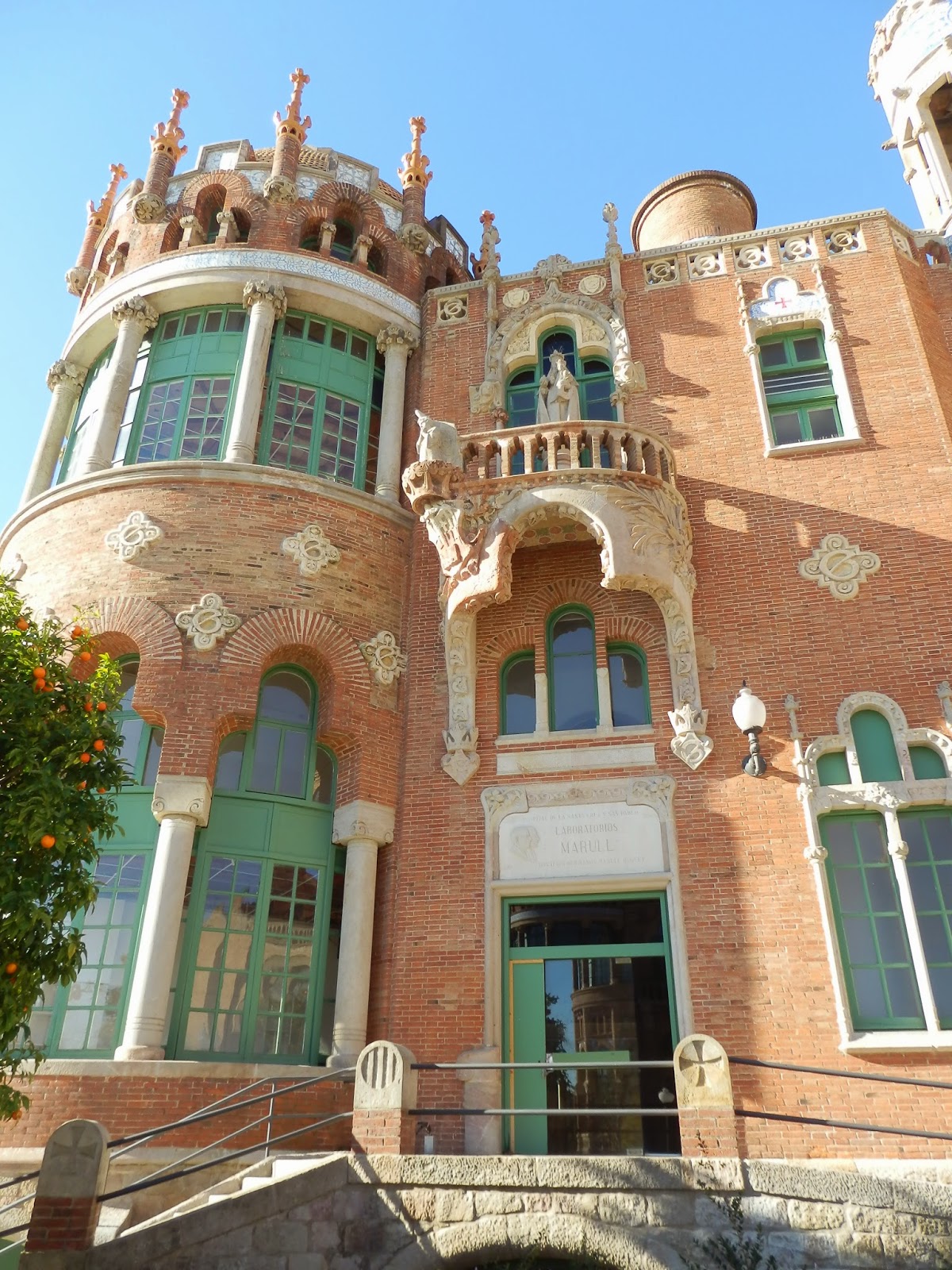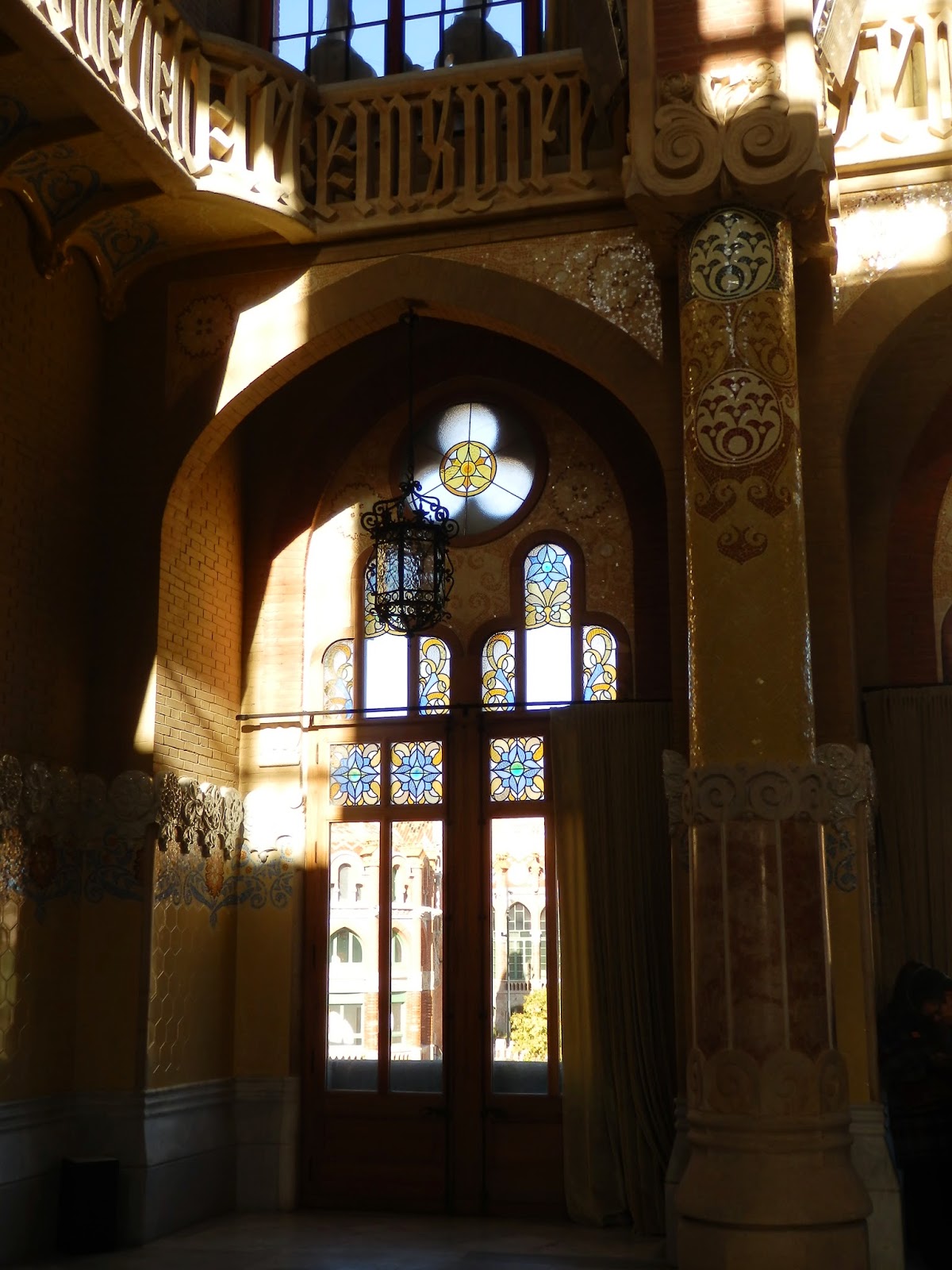Our day of travel from Seville to Barcelona was not the best of days, with problems with our initial connection, difficulty getting our bearings on the map, walking to the wrong address (thankfully only a block from the real address) and experiencing problems paying for the accommodation. As a result, once we had settled in, we decided on the simplest of tasks for the remainder of the afternoon.
Our apartment was located within walking distance of the Sagrada Familia (and spitting distance of Hospital Sant Pau) and so we wandered down the Avenue de Gaudi in search of the tourist bureau. There were a few things we needed to know;
a) what would be open on January 1 what with it being a religious holiday?
b) would any other days during our stay be affected?
c) what is the best way to buy tickets for the Sagrada Familia given we wanted them for a different day?
As it was dusk, we got to see the building in day light and at night and so were fortunate enough to send messages to family and friends commiserating our proximity to this unfinished monstrosity.

Being within spitting distance of the Hospital de la Santa Creu i Sant Pau, having just read about it in the plane magazine and knowing it hadn't been open when my Aunt and Uncle had visited Barcelona last, we decided that the following morning, this had to be our first stop.
I'd stumbled upon it on my initial reconnaissance of the area and a glimpse of the facade was enough to decide it was worth doing first and foremost while we still decided what to spend the rest of our days seeing.
Dad did experience a 'little' bit of difficulty getting a clear shot of the front facade without any tourists. He may have snapped at a tourist or two who decided that centre front was the perfect spot to stop and check their emails.

The hospital is a complex rather than a single building, a sequence of separately housed departments stretching up the gradual incline of the internal avenue. Originally it had been intended that it would be part of a much larger complex of 48 pavilions but this was reduced to 27, of which only 16 were modernista and only 12 of these by Montaner.
Our apartment was located within walking distance of the Sagrada Familia (and spitting distance of Hospital Sant Pau) and so we wandered down the Avenue de Gaudi in search of the tourist bureau. There were a few things we needed to know;
a) what would be open on January 1 what with it being a religious holiday?
b) would any other days during our stay be affected?
c) what is the best way to buy tickets for the Sagrada Familia given we wanted them for a different day?
As it was dusk, we got to see the building in day light and at night and so were fortunate enough to send messages to family and friends commiserating our proximity to this unfinished monstrosity.

Being within spitting distance of the Hospital de la Santa Creu i Sant Pau, having just read about it in the plane magazine and knowing it hadn't been open when my Aunt and Uncle had visited Barcelona last, we decided that the following morning, this had to be our first stop.
I'd stumbled upon it on my initial reconnaissance of the area and a glimpse of the facade was enough to decide it was worth doing first and foremost while we still decided what to spend the rest of our days seeing.
Dad did experience a 'little' bit of difficulty getting a clear shot of the front facade without any tourists. He may have snapped at a tourist or two who decided that centre front was the perfect spot to stop and check their emails.
 |
| The ceiling of the gift shop |

The hospital is a complex rather than a single building, a sequence of separately housed departments stretching up the gradual incline of the internal avenue. Originally it had been intended that it would be part of a much larger complex of 48 pavilions but this was reduced to 27, of which only 16 were modernista and only 12 of these by Montaner.
Aside from the astounding architecture, what was rather remarkable about the complex was that even as a working hospital, the architect had assigned each patient an area of 145m², including the landscaped gardens.
Each building within the complex is uniquely decorated with different patterns and animals, but at the same time fits within the style of the whole complex because at first glance they all look identical.
Each building within the complex is uniquely decorated with different patterns and animals, but at the same time fits within the style of the whole complex because at first glance they all look identical.
These buildings are interconnected via a series of underground tunnels. although no longer used as part of the hospital (one of the domes having collapsed and injured 16 people already waiting in the hospital's waiting room) the majority of the restored, reinforced and reconstructed buildings are not open to the public as they are now used as offices by various companies.
One of the old wards is open, restored to its original appearance, as is the general surgery building and the administrative building.
 |
| Through the open door |
While the surgery building contained a delightful little exhibition explaining the restoration that was undertaken over the last five years, it is the administration building that is most noteworthy. Within, the walls, ceilings and floors are decorated with floral mosaics while light streams in through floor length windows.
When compared with the other modernisme pieces around Barcelona, it is evident that this is NOT Gaudi, but instead the work of Lluis Domenech i Montaner who's design are far more in keeping with the Art Nouveau movement that was sweeping through France. Like Gaudi his work is grounded in nature, but more with the aim of bringing the outside in through the use of colours and floral patterns than through inspiration from the shapes and designs.

Having admired this at length (and scowled at another inconsiderate tour guide) we dashed back to the apartment for a bite before heading out. Our ultimate aim was Park Guell but we decided to take the metro to the end of the line (just past the park) and then walk down. Mum's logic said that because the park was below the metro stop on the map it would be a down hill walk. Yet right. Another interesting looking park between the metro stop and the Park Guell was Parc Creueta del Coll, basically a caldera with high steep slopes on one side (our side) and easy access on the other. Us being us, we climbed the outside of the steep side for views from the rim looking down over Barcelona.
Truthfully I was a little disappointed by this park, but then the only map we had which featured these outskirts depicted a caldera with a pond-y type thing in the bottom in which sat a bubble statue of an octopus. So that is what I expected, something that combined the slopes of Santorini a little more than Parc Creueta del Coll.

Having recovered our breaths we headed in the direction Park Guell from the back end. Goodness knows how we would have retraced our steps back up to the caldera if we'd had to, for the path we took was almost through allotments and housing developments but, with a little help from a friendly local we made our way to yet another Mirador. From there we traipsed down the various paths into Park Guell and towards the constructions that are due to Gaudi. Unfortunately (something some of the Barcelonains are not happy about) the main Gaudi part of the park is actually only accessible with a timed entry ticket. Not thinking highly enough of the architect we hovered on the outskirts and make use of our camera zooms. And dare I say it probably got some better shots than if we'd been in there amongst the pieces.
While the zigzaggy seats are delightful I'm not sure I'm a fan of the drippy/bouldery cave structure he littered the rest of the park with.

The day ended on a note of annoyance. Tegan and Andy had recommended a tapas bar just around the corner from one of the exits and we found it, waited an hour for it to open then realised there was a sign on the door that said they were shut until the 4th of January, the day after we left the city. Three very cold and unimpressed tourists then headed back into town for food.

Having admired this at length (and scowled at another inconsiderate tour guide) we dashed back to the apartment for a bite before heading out. Our ultimate aim was Park Guell but we decided to take the metro to the end of the line (just past the park) and then walk down. Mum's logic said that because the park was below the metro stop on the map it would be a down hill walk. Yet right. Another interesting looking park between the metro stop and the Park Guell was Parc Creueta del Coll, basically a caldera with high steep slopes on one side (our side) and easy access on the other. Us being us, we climbed the outside of the steep side for views from the rim looking down over Barcelona.
Truthfully I was a little disappointed by this park, but then the only map we had which featured these outskirts depicted a caldera with a pond-y type thing in the bottom in which sat a bubble statue of an octopus. So that is what I expected, something that combined the slopes of Santorini a little more than Parc Creueta del Coll.

Having recovered our breaths we headed in the direction Park Guell from the back end. Goodness knows how we would have retraced our steps back up to the caldera if we'd had to, for the path we took was almost through allotments and housing developments but, with a little help from a friendly local we made our way to yet another Mirador. From there we traipsed down the various paths into Park Guell and towards the constructions that are due to Gaudi. Unfortunately (something some of the Barcelonains are not happy about) the main Gaudi part of the park is actually only accessible with a timed entry ticket. Not thinking highly enough of the architect we hovered on the outskirts and make use of our camera zooms. And dare I say it probably got some better shots than if we'd been in there amongst the pieces.
While the zigzaggy seats are delightful I'm not sure I'm a fan of the drippy/bouldery cave structure he littered the rest of the park with.

The day ended on a note of annoyance. Tegan and Andy had recommended a tapas bar just around the corner from one of the exits and we found it, waited an hour for it to open then realised there was a sign on the door that said they were shut until the 4th of January, the day after we left the city. Three very cold and unimpressed tourists then headed back into town for food.
































































No comments:
Post a Comment